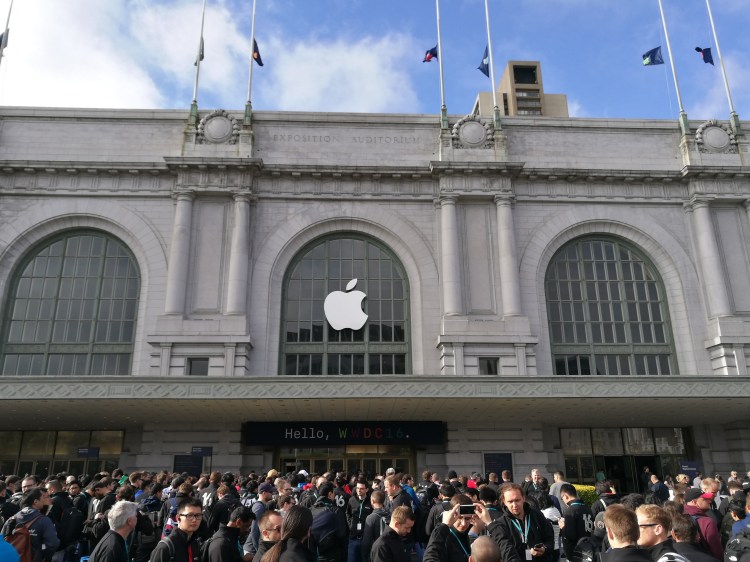As WWDC 2016 came to a close, millions of starry-eyed developers poured out of Moscone West in San Francisco and turned off their livestreams, ready to get to work on brand new features. But this time, more than in years past, another group should be excited about the Apple bonanza: marketers.
Apple has announced half a dozen changes that should grab any marketer’s attention. Siri, the intelligent assistant, will now be open to third-party integrations, as will iMessage and Apple Maps. Apple Pay will become available on the web, potentially changing life for retailers. New iOS lock screen notifications will allow users to see and do more without entering apps. And in a pre-WWDC reveal, we found out about upcoming sponsored search ads in the App Store.
The common theme throughout is a new level of openness from Apple to outside developers and ideas. Take iMessage for instance: The messenger will let in lightweight apps, like a new DoorDash app that lets friends collaborate on food delivery orders. Letting developers into its own apps is new for Apple. Copying ideas that aren’t thoroughly proven is also an uncommon move. The iMessage integrations seem to choose a different path from the chatbot craze sweeping Western chat apps; instead they look more like China’s WeChat, a model that hasn’t yet been proven in the West.
Newfound openness from Apple toward third parties means new opportunities to make money and expand on its massive platforms, especially iOS. But the sheer number of changes makes for difficult prediction. Here’s what I think will happen, starting today and moving into the coming months.
For now, we’ll see a lot of experimenting
Developers will scramble to integrate with Siri, iMessage, and Apple Maps — but most of these early integrations will be experimental. For many years, Apple has operated as a closed ecosystem, which also means we don’t know much about the usage of these apps. How often do people open Siri? Could users really leave behind their WhatsApp and Viber to open iMessage more often? Isn’t Apple Maps too far behind Google Maps to be significant?
In the weeks after these services open their doors, developers will begin teasing out this usage information, as well as learning how ordinary people will discover and use their integrated apps. How easily this discovery can take place largely depends on Apple. In the best case scenario, Apple will work hard to open up its apps to scrutiny, allowing attribution of installs and measurement of usage.
Over on the App Store, the same process will be taking place with the new sponsored ads. Many iOS developers are cautiously optimistic about the new ad format. While there is reason for optimism, it’s also a massive game changer as the App Store could effectively become pay-to-play. More than ever, mobile app marketing is important to publishers of all sizes and requires a laser focus on measuring activities that attract the highest-quality app users. Before investing deeply, developers and marketers will want to learn a lot about the users coming from search ads — just as they already do in the many third party ad platforms on iOS.
At the same time, app marketers in particular will love the new lock screen notifications, which will allow them to do more with their messaging, from sending users light-touch experiences that don’t actually open an app, to pushing users directly to a specified screen or destination. When correctly targeted, these types of notifications can increase all the engagement KPIs that marketers salivate over.
Soon, we’ll see a community begin to emerge
Siri will be competing hard with Google Assistant, Amazon Alexa, Microsoft Cortana, and many others. This will be a formative time for assistants. Which ones will actually be able to improve the lives of their users? Integrations are key, since much of what we want to do is already in third-party services, whether it’s booking a ride, sending a photo, or making a payment.
The WWDC announcement limited integrations to several types. But Siri’s competitors won’t allow it to stand still, and in fact, Apple’s Craig Federighi has already stated that the initial integration types are based on the intents Apple currently understands best. As the system expands, more brands will be able to hook in, using SiriKit to define when and how their services are called. Understanding the user side of the equation — the domain of marketers — will help establish footholds on Siri. This will also hold true for iMessage and Apple Maps.
Apple Pay, which is so far one of the best new payment services, will be making headway in reducing friction from online payments made with Apple devices. Marketers will increase their margins from targeting Apple users and, in turn, will reinvest more of their budgets into capturing these users — driving up acquisition costs for everyone else in the process.
And for all types of marketers, the concept of omnichannel marketing will continue to grow, fueled in part by the portals Apple is opening into its many services. Apple already “gets” omnichannel, as evidenced by the continuity across its own apps and devices. The next step for the company is building the frameworks for a continuous experience across devices, apps, and assistants. Major partners like Uber will be first in line, but others will surely follow.
Oren Kaniel is CEO of AppsFlyer.
VentureBeat's mission is to be a digital town square for technical decision-makers to gain knowledge about transformative enterprise technology and transact. Learn More

